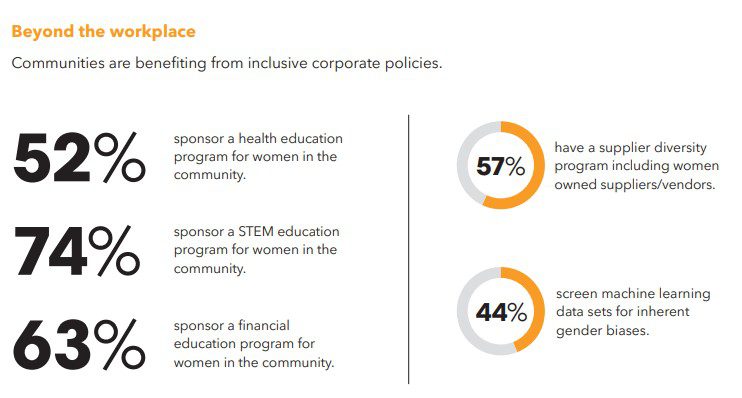Lessons on inclusion from Bloomberg’s gender equality index
Here’s what top companies are doing to make their workplaces equitable and inclusive.
Why You Should Care
Diversity is good for business.
But actually having an equitable workplace is easier said than done.
Here is what the top companies are doing, according to Bloomberg's newest gender equality index.
Eight years ago, in 2015, Bloomberg launched a gender equality index (GEI) with the simple goal of increasing “visibility into the S in ESG”, Sophia Sung, leader of the GEI team in the ESG data department at Bloomberg, tells UNLEASH.
To do this, public companies voluntarily disclose their gender metrics with Bloomberg. They are then scored against the reporting framework that underpins the GEI – there are asked 70 questions across five pillars: the leadership and talent pipeline, pay parity, inclusive culture, anti-sexual harassment policies and external brand (aka companies’ customer or community-related policies).
The idea is that the GEI is a “touchstone” for companies, and particularly HR teams, who want to “track their progress in gender inclusion”. They can figure out whether their diversity programs are having the desired effect on both employees and business bottom lines, and then identify areas where they need to improve.
According to Sung, companies can also use the GEI to “unite as a corporate community and drive social change”, plus it helps HR teams at companies who are not yet in the index to figure out the gold standard around gender equality at work.
Because the index is standardized, it enables “investors to compare how companies around the world are investing in women in the workforce, the supply and the communities in which they operate”. Remember, diversity and inclusion is good for business.
The state of gender equality in 2023
In 2023, 620 companies submitted their data to Bloomberg’s gender reporting framework – this is an 11% increase on 2022 – and 484 met the threshold to be included in the GEI itself (a 16% increase year-on-year).
These companies came from 11 sectors and across 45 countries; they have a combined market capitalization of $16 trillion. On average, they answered 97% of the 70 questions, and their inclusion score was 73%.
So, what do these gender inclusive companies have in common?
While the companies’ collective scores were up across the five pillars, the biggest improvement in 2023 was around anti-sexual harassment policies (7% year-on-year or 3.65 points) – 478 companies disclosed this information, and 63% (303) now require anti-harassment training annually.
In addition, three quarters of GEI members have a chief diversity officer whose primary function is to manage diversity and inclusion initiatives. The fact that “the tone is set from the top” is crucial for furthering progress and role-modelling good behavior, according to Sung.
She adds that companies are increasingly focusing on integrating diversity policies into executive evaluations. “This year 64% of GEI members implemented diversity and inclusion goals for managers in performance reviews, an 8 point increase from last year” – this is on top of 86% offering unconscious bias training, and 74% tracking if managers complete the program.
Another great thing that GEI members were doing was leveraging “machine learning to prevent algorithms from perpetuating gender bias”, Sung notes.
“This is a fantastic use case for expanding on technology that already exists and implementing it to better understand gaps in other portions of the business” – this action is something that companies big and small can do.

Bloomberg’s 2023 GEI.
Continuing the conversation about what pleased and surprised her most about the 2023 GEI, compared to previous years, Sung highlights: “The global commitment to data disclosure, especially in APAC, a region that is sometimes considered earlier in its ESG journey”. 21 new companies in APAC took part in the framework and their average disclosure score was 95%.
This “shows tremendous effort in taking ESG more seriously than ever before”, according to Sung. However, EMEA was the leading region – with the highest average score of 75% (a 2% on 2021).
In terms of sectors, financial, utilities and communication had the highest overall score (74%) – communications saw the biggest improvement on 2022 figures (4%). Examples of communications employers in the 2023 index include Vodafone, Verizon, AT&T, Deutsche Telekom, and Telefonica Brasil.
Areas for improvement on inclusion
While there are lots of positives to be taken from the 2023 GEI, there are still many areas that global employers need to work on if they want to be truly inclusive employers, and drive social change.

Sophia Sung, Governance Scoring, PAY, and Gender-Equality Index Team Leader, Bloomberg.
While there has been progress around the leadership and talent pipeline – 50% of entry-level positions in GEI member companies are filled by women – this declines to 24% for executives and 8% for CEOs.
“An area where we see a plateau in progress is in the career pipeline. This displays the repeated pattens that educated women are valued in the workforce, but may not have access to the right tools to rise and thrive in the talent pipeline,” states Sung.
While this phenomenon occurs across industries, the specific solutions will vary by sector, but also company and individual.
“A key learning is to engage with teams in order to understand what barriers they’re experiencing and areas of focus. When a company provides a space for feedback like an engagement survey they can better understand specific action points, and develop…an action plan”, adds Sung.
In line with the need to lead from the top, increasing the number of women at executive and CEO levels is important for driving inclusion, and particularly achieving pay parity. Bloomberg’s 2023 GEI found that the gender pay gap is lower when a female CEO is present.
While there has been some progress around the pay gap (a drop from 19% to 17.6% year-on-year) – and there are promising signs of future improvement because 70% of organizations said they had conducted a pay audit and 60% had publicly disclosed the gender-based differences in their compensation – there is a lot more work to be done here.
In addition, although Sung is pleased about progress around unconscious bias training – this is “something that is often tied to recruitment efforts and interviews”, when companies “can think beyond just recruitment”.
“Bias training focused on recruitment is about diversity. Continued bias training helps foster a culture that’s more inclusive”, states Sung.
There’s clearly a lot of work to be done by employers inside the GEI, and lots of lessons to be learnt for those outside the index. Despite this, Sung is optimistic about the 2023 data and believes the future is bright.
She advises that HR teams focus on those action plans this year. “Completing something like the GEI provides companies with a starting point. The framework and process prompts them…to understand the next steps and hold themselves accountable to effect change”.
The International Festival of HR is back! Discover amazing speakers at UNLEASH America on 26-27 April 2023.
Sign up to the UNLEASH Newsletter
Get the Editor’s picks of the week delivered straight to your inbox!

Chief Reporter
Allie is an award-winning business journalist and can be reached at alexandra@unleash.ai.
